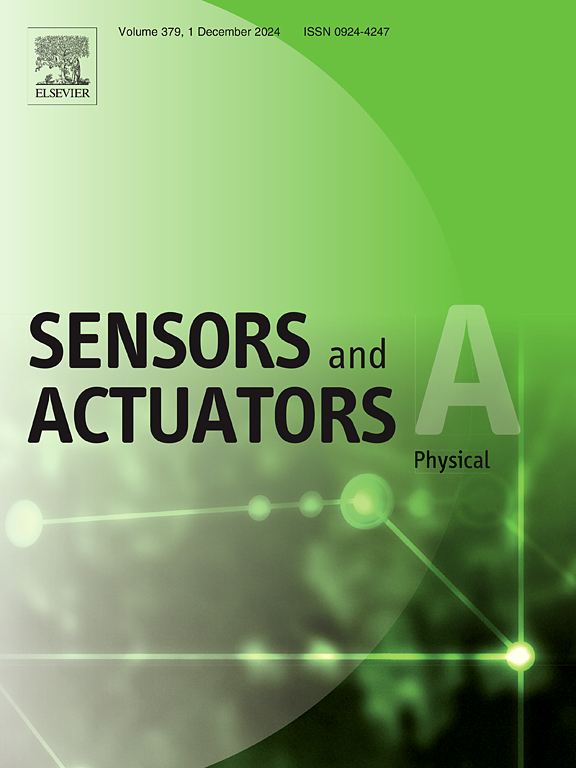Colorimetric sensors of ultraviolet-C light using diacetylene-zinc(II)-zinc oxide nanocomposites with tunable sensitivity
IF 4.1
3区 工程技术
Q2 ENGINEERING, ELECTRICAL & ELECTRONIC
引用次数: 0
Abstract
Polydiacetylene (PDA) material-based colorimetric sensors have been devised for monitoring ultraviolet-C (UVC) light. However, it is rather difficult to systematically control their sensitivity. This work introduces an easy and inexpensive approach for developing diacetylene/zinc(II)/zinc oxide (DA/Zn2+/ZnO) nanocomposites as colorimetric sensors of UVC light. Here, we demonstrate the ability to tune the sensitivity of the nanocomposites to UVC light by varying different parameters including ZnO ratio, ZnO size, and alkyl chain length of DA monomers. We have found that the increase of ZnO ratio significantly enhances the UVC sensitivity. Furthermore, the color transition from blue to purple upon prolonged exposure to UVC light can be controlled by adjusting the ZnO ratio. Interestingly, the use of ZnO quantum dots with a diameter of 3.8 nm drastically increases the sensitivity to UVC light. The adjustment in DA alkyl chain length also enables fine-tuning of sensitivity. The shortening of the alkyl chain length at the tail and headgroup position strongly influences the color-transition behaviors of the nanocomposites upon increasing the UVC irradiation time. Two different types of UVC sensors can be fabricated including flexible film and hydrogel bead sensors. These sensors exhibit a color transition from yellow to green to red as UVC exposure increases from 0 to 16.4 J/cm2.
使用具有可调灵敏度的双乙炔-锌(II)-氧化锌纳米复合材料的紫外线-C 光比色传感器
基于聚二乙炔(PDA)材料的比色传感器已被设计用于监测紫外线-C(UVC)光。然而,要系统地控制其灵敏度却相当困难。这项工作介绍了一种简便、廉价的方法,用于开发双乙炔/锌(II)/氧化锌(DA/Zn2+/ZnO)纳米复合材料,作为紫外线的比色传感器。在此,我们展示了通过改变不同的参数(包括氧化锌比例、氧化锌尺寸和二乙炔单体的烷基链长度)来调节纳米复合材料对紫外光的灵敏度的能力。我们发现,氧化锌比例的增加会显著提高紫外线灵敏度。此外,通过调节氧化锌的比例,还可以控制紫外线长时间照射时从蓝色到紫色的颜色转变。有趣的是,使用直径为 3.8 纳米的氧化锌量子点可大幅提高对紫外线的灵敏度。调整 DA 烷基链的长度也可以对灵敏度进行微调。当紫外线照射时间增加时,尾部和头部烷基链长度的缩短对纳米复合材料的颜色转换行为有很大影响。可以制造出两种不同类型的紫外线传感器,包括柔性薄膜和水凝胶珠传感器。当紫外线照射从 0 焦耳/平方厘米增加到 16.4 焦耳/平方厘米时,这些传感器表现出从黄色到绿色再到红色的颜色转变。
本文章由计算机程序翻译,如有差异,请以英文原文为准。
求助全文
约1分钟内获得全文
求助全文
来源期刊

Sensors and Actuators A-physical
工程技术-工程:电子与电气
CiteScore
8.10
自引率
6.50%
发文量
630
审稿时长
49 days
期刊介绍:
Sensors and Actuators A: Physical brings together multidisciplinary interests in one journal entirely devoted to disseminating information on all aspects of research and development of solid-state devices for transducing physical signals. Sensors and Actuators A: Physical regularly publishes original papers, letters to the Editors and from time to time invited review articles within the following device areas:
• Fundamentals and Physics, such as: classification of effects, physical effects, measurement theory, modelling of sensors, measurement standards, measurement errors, units and constants, time and frequency measurement. Modeling papers should bring new modeling techniques to the field and be supported by experimental results.
• Materials and their Processing, such as: piezoelectric materials, polymers, metal oxides, III-V and II-VI semiconductors, thick and thin films, optical glass fibres, amorphous, polycrystalline and monocrystalline silicon.
• Optoelectronic sensors, such as: photovoltaic diodes, photoconductors, photodiodes, phototransistors, positron-sensitive photodetectors, optoisolators, photodiode arrays, charge-coupled devices, light-emitting diodes, injection lasers and liquid-crystal displays.
• Mechanical sensors, such as: metallic, thin-film and semiconductor strain gauges, diffused silicon pressure sensors, silicon accelerometers, solid-state displacement transducers, piezo junction devices, piezoelectric field-effect transducers (PiFETs), tunnel-diode strain sensors, surface acoustic wave devices, silicon micromechanical switches, solid-state flow meters and electronic flow controllers.
Etc...
 求助内容:
求助内容: 应助结果提醒方式:
应助结果提醒方式:


